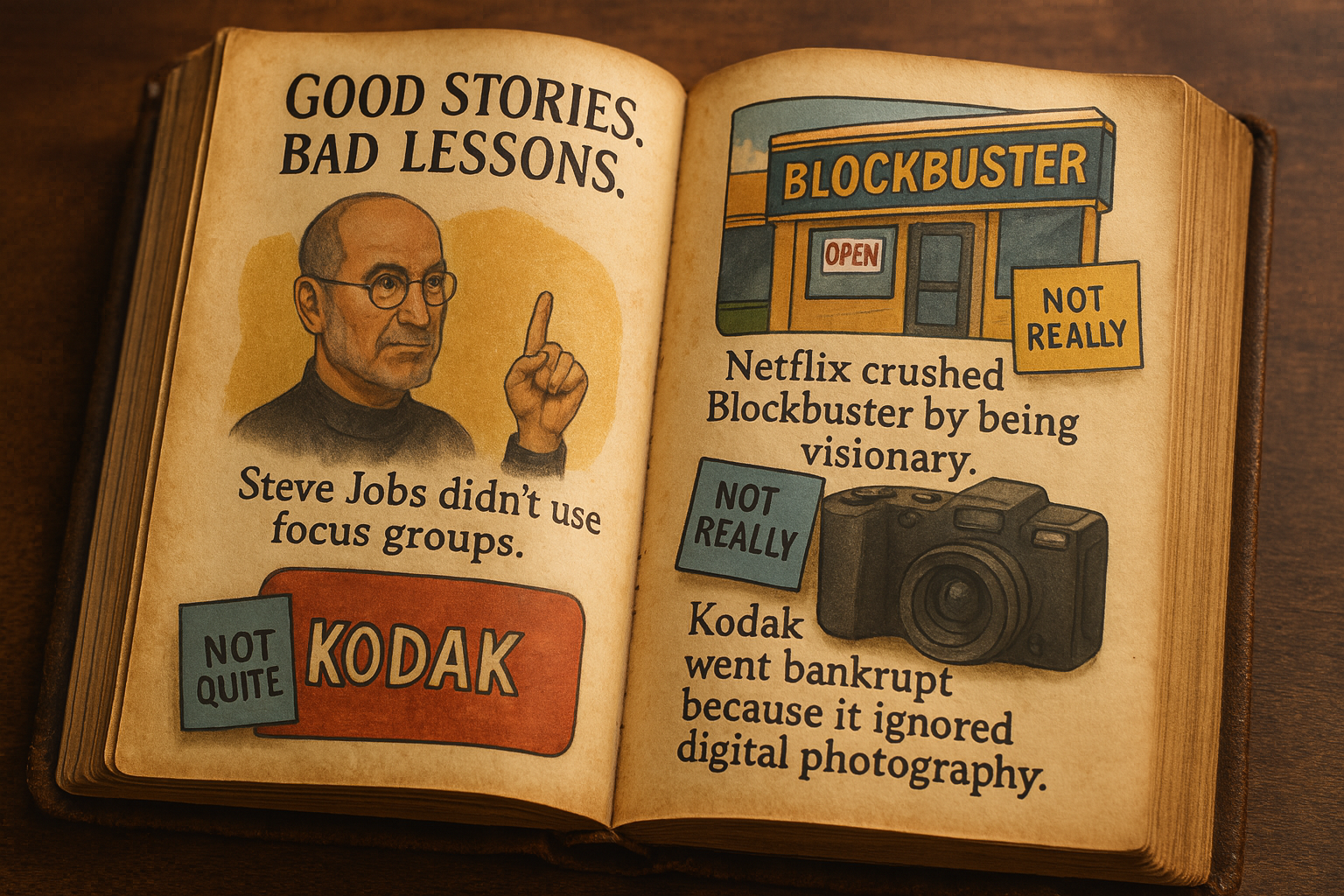Welcome to Musings—
A space where we cut through the noise and get to the heart of effective leadership and strategy execution. Here, we share hard-earned insights, practical frameworks, and candid reflections to help you navigate the complexities of leading teams and driving change.
Each post is designed to be a quick, impactful read—something you can digest between meetings and apply immediately. Whether you're refining your leadership approach, tackling execution challenges, or seeking to foster a more cohesive team, you'll find valuable takeaways here.
Dive in, reflect, and let's grow together.
The Strategic Power of a Well-Chosen Metaphor
We humans aren’t good at taking in lots of completely new information. Metaphors lighten the load and speed up clarity. They pin new ideas to something people already understand so they can act on them faster.
The Illusion of Alignment
Alignment isn’t everyone nodding in agreement. You can’t determine alignment with a yes or no question. Alignment runs too deep for that.
True alignment is when everyone making the same decision when you’re not in the room.
When alignment isn’t real, the cracks show up fast.
Stop Mistaking Financial Targets for Objectives
The Problem: Scoreboards don’t create clarity
A target tells you what outcome you want, but not what you must become or improve to achieve it.
Yes, teams can act on “grow revenue.” But those actions will fragment—each group doing what makes sense in their lane. One team discounts. Another raises prices. Marketing adds promos. Ops tightens costs.
Everyone’s rowing, but not in the same direction.
Good Stories. Bad Lessons.
Scroll LinkedIn long enough and you’ll see the usual suspects:
Posts claiming Steve Jobs didn’t believe in market research.
That Netflix beat Blockbuster because they had more vision.
That Kodak went bankrupt because it ignored digital photography.
They make for great click bait. Visionaries as heroes, analysts as villains. The punchline is always the same: one bold idea is all it takes. What’s missing is the part that actually determines who wins — execution.
Let’s take them one at a time.
A Balanced Diet of Metrics, Strategy, and Team Chemistry
Push too hard in one direction, and nature pushes back. Forests catch fire. Rivers overflow. Ecosystems collapse. Balance is nature's resilience.
The same is true in business. When strategy gets lopsided, progress in one area can come at the unintended expense of another.
From “AAAGH!” to Amazing: The Power of Committed Execution
Inside organizations, we get excited about clever concepts and breakthrough plans. But even brilliant strategy—without full commitment—can fall flat. A great idea, half-executed, just looks dumb. Or worse, confusing.
Strategy isn’t self-fulfilling. It needs people to bring it to life with clarity, precision, and energy. Everyone playing their part. Everyone on tempo. Everyone believing it’s worth doing right.
The Smartest Person in the Room is the Room
“Reasoning is biased in favor of the reasoner.”
David McRaney dropped that gem in How Minds Change: The Surprising Science of Belief, Opinion, and Persuasion, and it’s one of those lines that just won’t leave me alone. It’s clever, sure. But it also nails something fundamentally true about how humans think—and why we’re better off thinking together.
When we reason on our own, our brains aren’t wired for objectivity. They’re wired for advocacy. We argue for our own perspectives with built-in bias and barely notice we’re doing it.
Our brains are also lazy. Or, to be more charitable, efficient. Reasoning takes effort. So we delegate that cognitive load to others. It’s why the best thinking happens in groups—especially diverse groups—where we can distribute the mental workload, challenge each other’s assumptions, and sharpen each other’s thinking.
The Dress Test for Leadership: Why Vague Strategies Split Teams
Do you remember The Dress controversy?
Back in 2015 a washed-out photo of a striped dress split the web: half the planet saw blue-black, the rest swore it was white-gold.
I recently came across an article that explained why so many of us conclusively saw something so different. Scientists found two key drivers: (1) the photo was low quality, forcing our brain’s visual system to “repair” missing data, and (2) people’s repairs depended on the light they were used to. Regular daylight dwellers mentally subtracted bluish light and perceived white-gold; night owls tended to discount yellowish bulbs and landed on blue-black. The real split was experience-driven guesswork by the predictive brain, which constantly fills gaps with prior knowledge to keep perception running smoothly.
That same shortcut shows up whenever leaders drop a half-lit strategy note.
The Lie of ‘Priorities’: Why Focus Is a Singular Discipline
Did you know the word priority was only ever used in the singular form for hundreds of years?
It entered the English language in the 1400s and meant the very first thing—the one item that came before all others. And for the next 500 years, that’s how it stayed. Singular. Clear. Undeniable.
Then somewhere in the 20th century, we started saying “priorities.” Plural.
As if by declaring five things “most important,” we could bend time and energy to our will. It’s like claiming there were multiple winners in a race. Everyone gets a trophy, right? But that’s not how performance works. Not in competition. Not in strategy. Real focus doesn’t allow for handing out participation ribbons. It means hard choices. It declares a winner. It says: this comes first.
Clarity Drives Execution
Clarity is the difference between strategy that moves and strategy that stalls. If your team doesn’t “get” the strategy, you have no chance of executing it. Yet, clarity doesn’t happen by accident. It requires discipline: cutting through ambiguity, prioritizing what matters most, and ensuring that every person understands not just the what, but the why behind the strategy.
Start with Why—Then Make It Theirs
Simon Sinek famously calls on us to “start with why.” But for strategy to truly stick, we also need to explain “why me?”
People commit when they see how their work matters—when the strategy doesn’t just make sense, but feels personal. That’s when execution takes off.
And behavioral science backs this up.
The Curse of BAU
Every organization wrestles with the challenge of implementing new strategies while keeping the current business running. Teams are already fully engaged in their “day jobs”—what’s often referred to as business as usual (BAU) or run-the-business (RTB) work. This tension between sustaining current operations and pursuing strategic change is one of the most common pitfalls in execution.
While it’s essential to continue delivering results for the existing business, the truth is the status quo isn’t enough. If it were, we wouldn’t need a new strategy. Something isn’t working—whether it’s a current problem or an emerging challenge—and change is necessary. But change doesn’t magically happen in the margins of an already packed calendar. To succeed, we have to intentionally make room for it.
No Retreat, No Regrets: Unlocking Strategic Momentum Through Commitment
When teams and leaders fully commit—when there’s no mental “escape hatch” of half-hearted support—they unlock a different level of focus, resilience, and momentum. This doesn’t mean blind loyalty or ignoring challenges. It means choosing a direction, aligning behind it, and moving forward with conviction.
And commitment has real, tangible benefits. Research shows that when leaders and teams fully commit to a strategic direction, they gain several advantages that boost execution: greater focus, stronger team cohesion, and increased resilience in the face of challenges.
When teams commit to a strategy, even with reservations, they experience powerful effects that strengthen execution. Focus improves, collaboration deepens, and momentum builds—driving both performance and team cohesion.
4 Steps to Turn Skeptics into Believers: Messaging for Change
When it comes to early communication about change, getting the message right is critical. Change inherently stirs emotions—uncertainty, excitement, fear, and hope. Our message must address these emotions head-on, guiding our audience from resistance to acceptance.
One of the most critical steps is clearly explaining the Why behind it. Why is change necessary? Why now? Why is this the right path? Without a compelling and well-articulated “Why,” even the best strategies will face resistance.
Over the years, I’ve developed a framework I call “Hook / Scare / Comfort / Inspire” to craft a message that answers these questions. It connects the logic of the change to the emotions of the people who will execute it.
From Moonshots to Milestones: How OKRs Propel Strategy Execution
When Neil Armstrong set foot on the moon in 1969, it wasn’t just the result of a lofty idea shouted from the rooftops. It was the culmination of a meticulously connected network of goals that guided every team and individual.[1] NASA’s mission—“land a man on the moon and return him safely to Earth”—was audacious, but it succeeded because it cascaded into precise objectives at every level. By breaking the impossible into achievable steps, NASA turned an aspirational vision into a coordinated effort that worked.
Every organization needs goals that do the same. Effective goals take strategy out of the abstract and turn it into meaningful, actionable work. When properly aligned, goals ensure every individual knows how their contributions matter.
But too often, organizations treat goal-setting as an HR-driven exercise focused on annual performance reviews. If your goals are primarily driven by HR, your strategy is probably doomed. This isn’t a knock on HR—it’s about understanding that goal-setting must be at the core of strategic execution, not just a tool for annual evaluations.
When goals are deeply tied to strategy, they can transform execution. A quality goal-setting process may produce useful performance data, but its real purpose is to bring clarity and motivation to the strategy, making it tangible and engaging for every individual involved.
The most effective framework for achieving this connection, in my experience, is OKRs—Objectives and Key Results.
Reduce, Reuse, Recycle: Tips for Org Excellence
Reduce, reuse, recycle”is a rallying cry for sustaining our planet’s precious resources. Guess what? We can apply that same mantra to sustain our own organizational precious resources. The limited resources at stake are time, money, and people. By adopting these principles, we can turn scarcity into opportunity, creating leaner, more focused, and more effective teams who have the capacity to execute our new strategies.
We’re naturally wired to believe that adding more is the solution—more resources, more tools, more tasks…more complexity. Yet, as research shows, this instinct for addition can bog us down, leading to diminishing returns.
The Hidden Step That Makes Good Strategies Great
Crafting a strategy is hard work. After investing time and energy into crafting a thoughtful plan, it can be tempting to call it done and move on. But here’s the truth: no strategy is perfect, and that’s okay.
The key to success isn’t perfection. It’s pressure-testing your strategy to refine it, uncover blind spots, and build support before execution. This step is called validation, and it’s the secret to turning good strategies into great ones.
Why Validation is Essential
Strategies created in a vacuum rarely hold up under real-world conditions. Without input from diverse perspectives, it’s too easy to miss critical risks or practical realities. That’s where validation comes in.
Six Hats, One Goal: Aligning Teams Without the Drama
Have you ever been in a meeting where every voice seemed to clash, ideas spiraled in circles, and no clear decisions emerged? Frustrating, isn’t it? I’ve been in more of those than I care to remember.
Dr. Edward de Bono’s Six Thinking Hats method is here to save the day. Developed in 1985, this simple yet powerful framework transforms chaotic discussions into structured, focused collaboration. By guiding teams to explore every angle of a problem systematically, it fosters open dialogue, minimizes defensiveness, and ensures every perspective is heard—without letting egos derail the process. Doesn’t that sound nice?
3 Ways to Get the Right People and Craft a Strategy That Actually Works
We've all heard experts say, "Get the right people in the room" when it comes to building a strategy. But what does that even mean? Vague advice like this isn’t helpful unless we dig deeper. Who are these people, why do they matter, and how do we leverage their insights effectively? Without clarity on this, we risk missing essential voices or creating a strategy that lacks focus.
So, what does it mean to get the right people in the room? Here are three key objectives:
Why Team-Built Strategies Win
Leadership has traditionally been about calling the shots from the top—a vision set by the leaders, a plan laid out, and the team expected to follow. But recent insights into how humans work best are turning this model on its head. Science says that when we co-create, we boost both engagement and outcomes in a way that top-down management can’t touch.
Let’s be clear: co-creation isn’t just another trendy term. It is a powerful way to improve strategic outcomes that adds both value and loyalty to any plan. When people play a part in creating a strategy, they’re way more likely to support it. And the reason why is rooted in some fascinating science – a mix of psychology, neuroscience, and even economics – that shows why shared creation sticks.




















